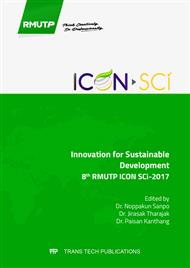[1]
W. Thitiprasert, C. Ratanasatien, S. Chitrakon, O. Watanesk, S. Chotechuen, V. S. Forrer, W. Sommut, S. Somsri, P. Samitaman and S. Changtragoon, Country Report on the State of Plant Genetic Resources for Food and Agriculture in Thailand. Department of Agriculture, Ministry of Agriculture and Cooperatives., Bangkok, 2007, pp.6-16.
Google Scholar
[2]
Sudjaroen, Y. Evaluation of Ethnobotanical Vegetables and Herbs in Samut Songkram Province. Procedia Engineering 32(2012) 160–65.
DOI: 10.1016/j.proeng.2012.01.1251
Google Scholar
[3]
Panya Sunintaboon. 2542 Chemical constituents of leaf and root extracts from Azima sarmentosa Benth and their biological activities Master. Science (Chemistry) Chulalongkorn University. Bangkok. (Thailand). Graduate School. 2542.
Google Scholar
[4]
Suriyaphan, O., Nutrition, Health Benefits and Applications of Pluchea indica (L. ) Less Leaves. Mahidol University Journal of Pharmaceutical Sciences, 41(2014), 1–10.
Google Scholar
[5]
Mahesh, A., Kumar, H., Mk, R., & Devkar, R. A., Detail Study on Boerhaavia Diffusa Plant for its Medicinal Importance-A Review. Research Journal of Pharmaceutical Sciences Res. J. Pharmaceutical Sci, 1(2012), 28–36.
Google Scholar
[6]
Hawkeswood, T. J., Dunn+, K. L., & Sommung, B., Acanthus ilicifolius L. (Acanthaceae), a new larval host plant for Hypolycaena erylus himavantus Fruhstorfer, 1912 (Lepidoptera: Lycaenidae) from Thailand, with a review on larval host plants of H. erylus and its weaver ant association. Calodema, 416 (2016).
Google Scholar
[7]
Lokhande, V. H., Gor, B. K., Desai, N. S., Nikam, T. D., & Suprasanna, P., Sesuvium portulacastrum, a plant for drought, salt stress, sand fixation, food and phytoremediation. A review. Agronomy for Sustainable Development, 33(2013), 329–348.
DOI: 10.1007/s13593-012-0113-x
Google Scholar
[8]
Khan, M. R., Omoloso, A. D., & Barewai, Y. (2006). Antimicrobial activity of the Derris elliptica, Derris indica and Derris trifoliata extractives. Fitoterapia. 77 (2006) 237-330.
DOI: 10.1016/j.fitote.2006.03.007
Google Scholar
[9]
GA Ayoola, HAB Coker, SA Adesegun, AA Adepoju-Bello, K Obaweya, EC. Ezennia, TO Atangbayila, Phytochemical Screening and Antioxidant Activities of Some Selected Medicinal Plants Used for Malaria Therapy in Southwestern Nigeria, Tropical Journal of Pharmaceutical Research. Tropical J of Pharm Res. 7(2008).
DOI: 10.4314/tjpr.v7i3.14686
Google Scholar
[10]
Saha, M., & Bandyopadhyay, P. K. Phytochemical screening for identification of bioactive compound and antiprotozoan activity of fresh garlic bulb over trichodinid ciliates affecting ornamental goldfish. Aquaculture, 473 (2017)181–190.
DOI: 10.1016/j.aquaculture.2017.02.009
Google Scholar
[11]
Shad, Anwar Ali; Din, Zakir U.; Bakht, Jehan. Antimicrobial, antioxidant potential and phytochemical screening of Fagonia olivieriPakistan journal of pharmaceutical sciences, 30 (2017) 697-703.
Google Scholar
[12]
Horwitz, W. and Latimer, G.W., 2005, Official Methods of Analysis of AOAC International, 18th Ed., AOAC International, Maryland, USA.
Google Scholar
[13]
Murray, S. S., Schoeninger, M. J., Bunn, H. T., Pickering, T. R., & Marlett, J. A., Nutritional Composition of Some Wild Plant Foods and Honey Used by Hadza Foragers of Tanzania. Journal of Food Composition and Analysis, 13 (2001)1–12.
DOI: 10.1006/jfca.2000.0960
Google Scholar
[14]
Ogonda, L. A., Muge, E. K., Mulaa, F. J., & Mbatia, B. N., Proximate composition of Rastrineobola argentea (Dagaa) of Lake Victoria-Kenya. African Journal of Biochemistry Research, 8(2014) 1–6.
DOI: 10.5897/ajbr2013.0720
Google Scholar
[15]
Ujowundu, C.O., Igwe, C.U., Enemor, V.H.A., Nwaogu, L. A and Okafor, O.E. Nutritive and Anti-Nutritive Properties of Boerhavia diffusa and Commelina nudiflora Leaves. Pakistan Journal of Nutrition 7 (2008) 90-92.
DOI: 10.3923/pjn.2008.90.92
Google Scholar
[16]
Edeoga, H.O., Okwu, D. E, and B. O, Mbaebie., Phytochemical constituents of some Nigerian medicinal plants. African Journal of Biotechnology, 4 (2005) 685-688.
DOI: 10.5897/ajb2005.000-3127
Google Scholar
[17]
Suman Kumar, R., Venkateshwar, C., Samuel, G., Gangadhar Rao, S., Phytochemical Screening of some compounds from plant leaf extracts of Holoptelea integrifolia (Planch. ) and Celestrus emarginata (Grah. ) used by Gondu tribes at Adilabad District, Andhrapradesh, India. International Journal of Engineering Science Invention, 8(2013).
Google Scholar
[18]
G. A, Ayoola., A. D, Folawewo., S. A, Adesegun., O. O, Abioro., A. A and Adepoju-Bello, H.A. B, Coker. Phytochemical and antioxidant screening of some plants of apocynaceae from South West Nigeria. African Journal of Plant Science, 9(2008).
DOI: 10.4314/tjpr.v7i3.14686
Google Scholar
[19]
Nuntavan Bunyapraphatsara, Vimol Srisukh, Aranya Jutiviboonsuk, Prapinsara Sornlek Wilaiwan Thongbainoi, Wongsatit Chuakul, H.S. Fong Harry., Pezzuto, John M and Jerry Kosmeder. Vegetables from The Mangrove Areas. Thai Journal of Phytopharmacy, 9(2002).
Google Scholar


